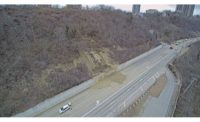Infrastructure
Work on Charleroi Lock and Dam in Western Pa. Nears Completion
Work on the $1.2B lower Monongahela River project began in 2004

Work by Trumbull-Brayman continues on the Charleroi Lock and Dam in Monessen, Pa., including testing the electric actuators used to open the new miter gates. The lock previously used hydraulics to open its gates.
Photo by Jeff Yoders/ENR
The U.S. Army Corps of Engineers' Pittsburgh Engineering District said work on the Charleroi Lock and Dam, a project that began nearly 20 years ago and whose budget has stretched to $1.23 billion in that time, will be completed by January.
Testing began the week of August 14 on the new lock chamber and Steve Fritz, program manager for megaprojects in the Corps' Pittsburgh District, said that it will be operational by late this year.
The Monongahela River's waters run south to north in western Pennsylvania and lock and dam 4 in Charleroi is located 41.5 miles from Pittsburgh. It's a major thoroughfare for more than a million tons annually of barged coal and other commodities to the Port of Pittsburgh. The project was originally authorized by the Water Resources Development Act of 1992 when the cost was $750 million and was expected to take 10 years to complete. The first construction funds were received in 1995. Delays in funding contributed to the protracted construction schedule.
The project was originally planned to have two separate lock chambers, one river side and one land side, but the Corps redesigned the project to have a single, larger lock chamber as project funding became an issue. The new lock is now 720 ft long and 84 ft wide. It was 360 ft long and 56 ft wide under its old configuration. That design dates back to a 1967 rehabilitation of its original 1931 design.
Because the chamber was only 360 ft long, it would previously take hours and multiple cuts for a tow to lock multiple barges through. The landside chamber, which has been the only operating chamber while joint venture contractor Trumbull-Brayman has been working on it since 2004, is planned to be taken out of service when the new riverside lock opens by January, but its future is in doubt. Lock and Dam two in Braddock, Pa., was also eliminated and replaced with a fixed-gate dam.
"We calculate that we can get 90% of the project benefits (from the original two-chamber design) with just the river chamber itself, and the removal of dam three and lock three," said Steve Frost, Corps project manager of the Lower Monongahela project. "So, that's what we're shooting for is 90% benefit."
Frost said a tow would be able to get through the lock in around 40 minutes with the new configuration. The USACE Pittsburgh District estimates the economic benefit for tow operators using the lock and dam to be $220 million a year after it opens.
Work that would keep the second chamber open has been delayed until at least the 2050s as it was not released by the last WRDA bill or the Infrastructure Investment and Jobs Act. After the project at Charleroi is completed, locks and dam three in Elizabeth, Pa., will be removed to create a single, navigable pass. Full removal of the dam and locks in Elizabeth is estimated to take about three construction seasons, Frost said.
Most construction and rehabilitation projects along the inland waterways system are funded with 65% coming from the federal government's general treasury and 35% from the Inland Waterways Trust Fund (IWTF), into which diesel tax fees paid by commercial users are deposited. Waterways users such as towboat operators have asked to contribute more to the fund by increasing the diesel tax to cut down on unplanned closures at locks operating more than 50 years beyond their originally planned design lives. Frost said that the Charleroi project is funded at around $1.1 billion right now with he most recent federal funding received for the Lower Mon project coming in the form of $111 million through the 2020 Further Consolidated Appropriations Act. The Lower Mon project did not receive any funding from the 2022 Consolidated Appropriations Act. Frost said the Lower Monongahela projects are currently expected to pick up another $43 million or $44 million in the next water and energy appropriations bills to finish Charleroi's final months of construction and testing as well as start-up work at Elizabeth.
The IWTF only has about $400 million a year to go toward these projects and that to fund all of the inland waterways projects already authorized, "we’re talking about billions,” said Jennifer Armstrong, director of government relations at Waterways Council, Inc., a Washington, D.C.-based lobbying organization that represents ports and inland waterways users.
The Charleroi Lock and Dam will also be renamed the John P. Murtha Lock and Dam, after the longtime western Pennsylvania congressman who died in 2010, when it fully opens.





